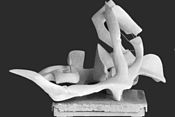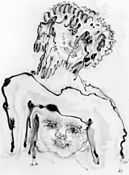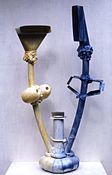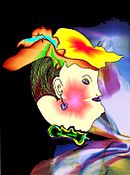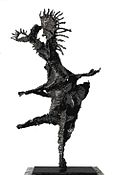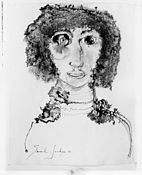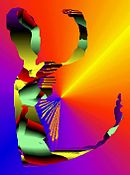- Sarah Jackson
-
Sarah Jackson 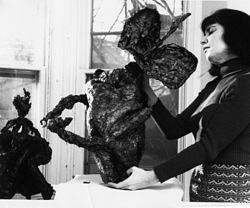
In her studio with wax Mythological Figure II, 1972Born 13 November 1924
Detroit, U.S.A.Died 18 May 2004 (aged 79)
Halifax, CanadaNationality American-Canadian Sarah Jeanette Jackson, née Sherman (Detroit, November 13, 1924 – Halifax, May 18, 2004) was a Canadian artist, who first became known for her sculptures and drawings and then became one of the pioneers of 20th century digital art. [1]
She was born in Detroit in 1924, the only daughter of Jewish emigrants from Poland. At Wayne State University in Detroit, she studied Humanities, receiving a BA and a MA degrees, her thesis being on color and texture in primitive and modern sculpture. She graduated in 1948 and left for Mexico City where she taught English at Mexico City College and began her life as an artist. [2]
In 1949, she passed through England to visit Henry Moore and then continued to Paris where Henri Pierre Roché (author of Jules and Jim) introduced her to Constantin Brâncuşi and arranged for her to exhibit a suspended sculpture at the 1949 Salon des Réalités Nouvelles. After her marriage with architect Anthony Jackson, the couple lived in London, where her first solo show took place at the Galerie Apollinaire in 1951. Over the next five years, she participated in various London group shows and in 1956 with her husband and the Italian painter Emilio Scanavino formed group four in the exhibition This is Tomorrow at the Whitechapel Art Gallery. That year the couple moved to Canada, where she continued to work in plaster and, later, wax and have her sculptures cast into bronze and exhibited in various galleries. In 1961, she created a large bronze Dancer for Cloverdale Mall in Toronto, a copy of which was purchased by Joseph H. Hirshhorn, who also bought other sculptures and drawings, which are now in the Hirshhorn Museum, in Washington, D.C. Jackson had been occasionally drawing and painting during the early 1950s, but from the latter part of the decade ink wash drawings became a major part of her work until the late 1980s. Her last bronze sculptures, three mythological figures, are in the Art Gallery of Nova Scotia.
In 1973, with the increasing cost of casting, Jackson turned to making sculptures out of everyday products and polyurethane foam. The following year, she started to explore the artistic possibilities of using current technology and was provided with a copier machine by Xerox Corporation, which subsequently donated some of her works to the Smithsonian American Art Museum. Appointed artist–in–residence at the Technical University of Nova Scotia (Dalhousie University) in 1978, Jackson taught art and technology classes. She also arranged international copy art festivals and mail art exhibitions, believing that this could lead to an ideal democratic interchange between artists and the public, without regard to political, economic or cultural barriers.[3] Jackson documented these with published catalogues including the 1985 ‘’International Mail/Copier Art Exhibition’’ catalogue which received an award of excellence from the Art Museum Association of America. The assembled works were displayed both in London in 1987 and at the Canadian Museum of Civilization in 1992 and became part of the collection of the Canadian Postal Museum. Jackson also contributed to many art exhibitions abroad including two in Italy that were organized at Giuseppe Perotti School in Turin, 1987 and 1990,[4] and subsequently collaborated with Lidia Chiarelli and British poet Aeronwy Thomas in developing IMMAGINE&POESIA, a project that a few years later became the international artistic literary movement. During this period she also used copiers to create bookworks which are now in various collections including the National Art Library at the Victoria and Albert Museum (London). From 1995 on, she worked exclusively with computers. Jackson’s last retrospective exhibition titled ‘’Spirit Journey / Bodies of Work’’ at the Art Gallery of Nova Scotia in 2001 included bronze sculptures, ink drawings, mixed media assemblages, photocopier art and digital paintings. [5]
Her extant work includes over 70 sculptures in bronze and approximately 1000 ink drawings, 1200 computer paintings and 20 mixed media sculptures (most of these and her early plaster sculptures having been photographed but now missing). The artist’s own collection was bequeathed to her two children, Timothy and Naomi Jackson.
Contents
Gallery
Group and solo shows (selection)
- Salon des Réalités nouvelles, Musée des Beaux Arts, Paris, 1949
- Solo sculpture (with Emilio Scanavino, paintings), Apollinaire Gallery, London, 1951
- London group, New Burlington Galleries, London, 1952
- This is Tomorrow, Whitechapel Art Gallery, London, 1956
- Solo show, Here and Now Gallery, Toronto, 1959
- Solo sculpture (with Marion Scott, paintings), Montreal Museum of Fine Arts, Montreal, Quebec, 1960
- Sculpture 60, Sculptors Society of Canada, Montreal, Quebec
- Solo show, Dalhousie University Art Gallery, Halifax, Nova Scotia, 1964
- Confrontation 67, Quebec Sculptors Association, Place des Arts, Montreal, Quebec, 1967
- Solo show, St. Mary's University Art Gallery, Halifax, Nova Scotia, 1973
- Solo show, Xerographic Art, Galerie Scollard, Toronto, Ontario, 1976
- Copie-Art, Motivation V, Montreal, Quebec, 1981
- Solo show, Mount Saint Vincent University Art Gallery, 1981
- International Mail/Copier Art Exhibition, Technical University of Nova Scotia, Halifax, 1985
- The book as Art, National Museum of Women in the Arts, Washington, DC, 1987
- International Exhibition of Visual Poetry of São Paulo, Brazil, 1988
- Group A-Z, Vasarely Museum, Budapest, Hungary, 1991
- Guest artist, Art Travels: Mail Art Festival/L'art voyager: Festival d'art par correspondance, Canadian Postal Museum, Hull, Quebec, 1992
- MIDE Collection, Eden Court Gallery, Inverness, Scotland, 1993
- Copy art Show, XeroX Parc, Palo Alto, California, 1993
- First Biennale Art Electro-Images, Berlin, Germany, 1994
- International Copy Art Expo, Gallery Artbeam, Seul, South Korea, 1995
- Copy Book Art, Maerz Gallery, Linz, Austria, 1996
- ComputerKunst ’98, Gladbeck, Saalack, Dresden, Germany, 1998
- Pisa ’99, Pisa 2000, Mini graphic& Painting: International Biennial, Pisa, 1999, 2000
- 1/2000, Collège Jacques Cartier, Chauny, France, 2000
- Retrospective exhibition, Art Gallery of Nova Scotia, 2001
References
- ^ *Who's Who in America, Chicago: Marquis Who's Who. 1996.
- ^ Enrique F. Gual, "El arte abstracto de Jeanette Sherman". La Propiedad, Mexico, 4:9. February 1, 1949. 9.
- ^ Who's Who in American Art. New York: R.R. Bowker. 1995-96. 588.
- ^ http://immaginepoesia.wordpress.com/a-scuola-di-creativita-aeronwy-thomas-e-sarah-jackson/
- ^ Peter Dykhuis and Pamela Edmonds,Sarah Jackson: Spirit Journey / Bodies of Work. Halifax: Art Gallery of Nova Scotia. 2001.
Bibliography
- Robert Melville, "The New Sculptors", Harper’s Bazaar, 46: 33-34. January, 1952.
- Pierre Rouve, "Sculpture de Sarah Jackson", Prisme des arts, 6: 42. November, 1956.
- Guy Robert, "Eros et humour chez Sarah Jackson", Vie des Arts, 20: 30-31. Spring, 1975.
- Tom Coleman, "Xerox Art is No Copycat", Globe and Mail, Toronto. July 3, 1976.
- Peter Bromley, "Sarah Jackson", Visual Arts News, 1: 6-7. Fall 1977.
- Sarah Jackson. Doomsday Studios with the assistance of the National Film Board of Canada. video, 10 minutes. 1980.
- Donna Smyth, "Sarah Jackson’s Eyeconography", Atlantic Provinces Book Review, 12:16. May–June, 1985.
- Canadian Who's Who, Toronto: University of Toronto Press. 1996.
- David Liss, "Copy Art: What happened to the Pioneers?", Artfocus, 4: 20-23. Winter, 1996.
External links
Categories:- Canadian contemporary artists
- Canadian sculptors
- Canadian women artists
- American sculptors
- American women artists
- Jewish artists
- 2004 deaths
- 1924 births
Wikimedia Foundation. 2010.

